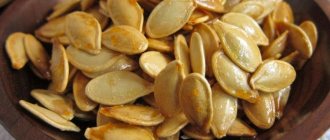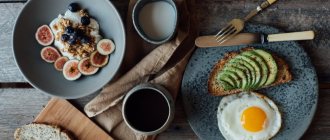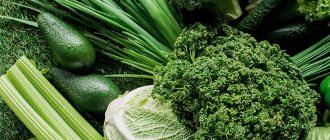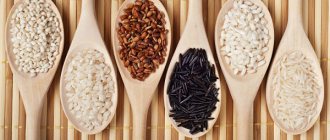Despite the fact that diabetes mellitus is an incurable pathology of the endocrine system, properly organized nutrition can provide a diabetic with a fairly high quality of life. Diabetes diagnosed as type 1 is insulin dependent. The patient's pancreas lacks the ability to produce insulin, the hormone responsible for transporting glucose into the cells and tissues of the body. Treatment of the disease includes regular injections of medical insulin and special nutrition for type 1 diabetes.
Types and rules of dietary nutrition
Therapeutic nutrition for diabetes, according to the classification of Professor V. Pevzner, includes the “Table No. 9” diet. The goal of the dietary diet is to normalize carbohydrate and fat metabolism and maintain a stable glycemic level. Depending on the type of disease, there are two types of diet “9-A” and “9-B”. Diet 9-B is based on the calculation of XE (bread units), which depend on the dosage of insulin administered and its type (long-acting or short-acting).
Insulin-independent patients are prescribed diet 9 “A”, which is more strict. In addition to controlling blood sugar levels, the diet is aimed at reducing body weight, since type 2 diabetes is characterized by obesity. In addition, the right foods limit the stress on the pancreas, maintaining its functionality. The criteria for choosing products for both types of diabetic nutrition are the same:
- GI (glycemic index) of the product. This value indicates the rate of glucose formation from food and its absorption into the systemic bloodstream. Foods with a high GI are excluded from the diet.
- Energy value. Preference is given to low-calorie foods.
- Percentage of nutrients (fats, proteins and carbohydrates).
The basis of nutrition for diabetes is slow carbohydrates (vegetables, cereals) and protein foods (dietary meats, fish and seafood, mushrooms, nuts).
Principles of a therapeutic diet
Dietary meals “Table No. 9” are organized according to the following rules:
- limit as much as possible the intake of monosaccharides (glucose, fructose, galactose) and disaccharides (sucrose, lactose, maltose) into the body;
- adhere to the drinking regime (from 1.5 to 2 liters of liquid per day);
- exclude the processing of products by culinary frying (only boiled, stewed, baked in foil products);
- eat at least five, optimally six times a day (three main meals, two snacks and a fermented milk product an hour before bedtime);
- observe the calorie content of dishes and portion sizes (the daily diet should be 2500–3000 kcal, a single main meal is 350–400 g);
- minimize the consumption of animal fats, replacing some of them with vegetable fats;
- carefully monitor your sugar levels relative to meals;
- limit salt and salty foods (ideally, switch to a salt-free diet);
- introduce low GI vegetables and fruits into the daily menu as a source of vitamins.
Patients with diabetes need to keep a “Diabetes Diary”, which records the medications taken, foods eaten, and drinks drunk.
Some useful tips
A multicooker will be a good helper in the household. The device has several modes (steam, stewing, baking), using which you can easily and quickly prepare healthy meals. When mixing minced meat for cutlets or meatballs, you need to discard bread (rolls). It is recommended to use Hercules No. 3 flakes. It is better to prepare salads not from boiled vegetables, but from fresh ones. They not only enrich the body with vitamins, but also regulate the functioning of the digestive system and help restore metabolism.
For dressing, it is recommended to use natural (without additives) yogurt, soy sauce, lemon juice, and vegetable oils. Sour cream 10% fat content is allowed. Before preparing chicken dishes (including broth), the skin should be removed from the bird. It contains a lot of “bad” cholesterol. Eggs are not prohibited on a diabetic menu, but their quantity should be limited to 2 per week.
Potatoes are allowed as a side dish once a week. It should be boiled “in its uniform”. Fried and pureed foods should be avoided. Culinary methods of processing foods include: boiling, steaming, stewing. Fried foods for diabetics are excluded from the diet. With this method of preparation, the caloric content of foods increases and the load on the weakened pancreas increases.
Cottage cheese dishes and milk porridges should not be flavored with sugar (berries are the recommended addition). Homemade compotes and jelly are also cooked without sugar.
Dinner must have a protein component. This will help maintain a feeling of fullness until the morning and will not allow your sugar levels to increase. The menu for each day is compiled taking into account the energy value and balance of nutrients. It is not recommended to completely exclude one or another product category. An hour before bedtime, you should drink a glass of kefir, acidophilus or yogurt. The permissible fat content is 2.5%.
You can enrich the taste of dishes by using spices allowed for diabetes. Turmeric goes well with meat dishes, cottage cheese and apples go well with cinnamon, boiled or baked fish is prepared with the addition of oregano (oregano). In addition, the use of ground black and white pepper, ginger root, and cloves is encouraged. The listed spices inhibit the absorption of glucose, which helps to avoid sugar spikes.
When preparing soups, it is not recommended to add potatoes and sauté vegetables.
Ready-made dough products are not allowed for consumption. To diversify your diet with baked goods, you should use special recipes for type 2 diabetics.
Basics of table No. 9-B
For maximum accuracy in calculating daily menu products for type 1 diabetes (diabetes mellitus), an XE value equal to 25 g of bread (hence the name) or 12 g of carbohydrates is used. Every day the patient is allowed to consume, on average, 24 units of bread. Products can be replaced according to taste, but a single meal should not exceed 8 XE.
Considering that eating with Diet No. 9 is recommended 5-6 times a day, the dosage of insulin and the amount of XE should adequately correspond to each other. In order to process 1 unit of bread without harm to health, a diabetic needs from 1.5 to 2.5 units. insulin. The exact amount depends on the stage of diabetes, age and physical activity of the patient. There is no need to calculate XE yourself. There are specially designed tables according to which the diabetic menu is compiled.
Sample food table
With morning and afternoon insulin injections, 2/3 of the amount of carbohydrates must be concentrated in these meals. You should eat after the injection after a quarter of an hour, and the second time - after 3 hours. If the medicine is administered before dinner, biscuits or dryers should be added to the evening kefir (ryazhenka, etc.). This will help prevent a sharp drop in sugar (hypoglycemia) during sleep. The diet for type 1 diabetes includes an increased amount of foods containing complex carbohydrates (relative to “Diet No. 9-A”).
Polysaccharides (complex carbohydrates) are absorbed slowly and do not cause “jumps” in sugar. In addition, insulin-dependent patients monitor their body weight less closely. Polysaccharides are:
Foods that lower blood sugar
- glycogen (found in protein foods);
- pectin (the main source is vegetables, fruits and berries);
- fiber or cellulose (present in abundance in vegetables and herbs);
- starch (is a component of potatoes, pasta, legumes and grains).
As for protein foods, their consumption does not have a big effect on blood glucose levels. The process of gluconeogenesis (the formation of glucose from amino acids) occurs slowly, without causing a dramatic change in the patient’s condition. In addition, many of the amino acids that the body needs cannot be synthesized on its own, but are obtained from protein. However, you should not limit the carbohydrate component of your diet too much.
A low-carbohydrate diet is allowed only in the compensated stage of diabetes and for a certain period of time. Otherwise, complications of a cardiovascular nature may occur (due to excess fat), on the renal apparatus and hepatobiliary system (due to the abundance of proteins in the body, excess uric acid may develop). A deficiency of carbohydrates in the diet leads to inhibition of brain activity and a decrease in body tone.
Important! You should not do diet therapy on your own. The doctor must select the correct nutritional system based on individual indicators.
Prerogative aspects of eating cereals for patients with diabetes
For diabetics, porridge is an integral part of the diet. Firstly, cereals are complex carbohydrates. They are slowly processed by the body, without causing a forced rise in blood sugar levels. Prolonged digestion of porridge does not cause a feeling of hunger for several hours.
This is a prevention of overeating and, as a result, excess weight gain. Secondly, many cereals and grains contain a sufficient amount of dietary fiber, which helps normalize digestive processes. Thirdly, cereals contain those useful elements that are prescribed to diabetics in the form of vitamin and mineral complexes.
Almost all cereals contain the vital group of B vitamins:
- B2 (riboflavin) - normalizes the metabolism of fats and proteins, helps improve vision;
- B1 (thiamine) - has a positive effect on the blood supply to organs and tissues of the body, participates in metabolic processes;
- B5 (pantothenic acid) - takes part in the restoration of damaged cells and tissues;
- B3 (niacin) – responsible for memory and attention, regulates heart function;
- B6 (pyridoxine) - activates the conduction of nerve impulses, increases blood circulation in brain cells, stabilizes the functioning of the nervous system;
- B4 (choline) – prevents the development of visceral obesity;
- B12 (cyanocobalamin) – normalizes the activity of the psycho-emotional state and the activity of the nervous system.
- B9 (folic acid) – eliminates sleep disorders.
Cereals contain minerals, essential amino acids, and polyunsaturated fatty acids.
Sweeteners
Regardless of the type of diabetes, sugar in its pure form is prohibited. For diabetic patients, the use of sweeteners in limited quantities is allowed. The most common are:
- trichlorogalactosucrose or sucralose;
- food additives: E950 (acesulfame potassium), 951 (aspartame), 952 (sodium cyclamate).
- stevioside (glycoside from the leaves of the stevia plant).
Some of the sweeteners have a number of contraindications and therefore require prior medical consultation.
Consumption of sugar substitutes does not affect glycemic levels
Prohibited, permitted and limited products
Since nutrition for diabetes is the basis of therapy, it is necessary to clearly differentiate food. It is allowed to prepare dishes only from approved products, but it must be taken into account that depending on the culinary processing, the glycemic index of products may change.
What you need to give up
Pathology of the first type is controlled with insulin injections, but this does not mean that the patient is allowed to eat absolutely everything. The following are absolutely prohibited:
- confectionery products (pastry, cakes);
- sweet butter and puff pastries;
- products made from sweet choux and shortbread dough;
- chocolate + sweets, ice cream;
- fast food products and dishes;
- meat and fish products prepared by smoking;
- chips, flavored snacks, popcorn;
- mayonnaise-based fatty sauces;
- bottled tea, packaged juices, lemonade, and any other sweet drinks.
Other prohibited foods by category
| Meat | Conservation | Fish | Cereals | Flour products |
| pork, duck, goose | meat and sprat pate, canned fish, fruit in its own juice, preserves and jams, pickled vegetables | preserves, cod liver | sago, semolina, white rice | pasta categories B, C, 1st and 2nd class, pasties, white bun (loaf) |
Fruits on the menu are selected according to the glycemic index. For diabetes mellitus, fruits indexed with a number higher than 60 (figs, grapes, papaya, carom, guava) are not recommended.
Strictly controlled products
A separate category consists of limited (limited for consumption) products. The bulk of them are foods with an average glycemic index (from 30 to 70 units). The most popular include:
- root vegetables: potatoes and beets;
- semi-finished products: dumplings, khinkali, dumplings, etc.;
- flour products: durum pasta, pancakes, pancakes;
- melons and fruits: pumpkin, watermelon, melon, pineapple, banana, persimmon, mango, kiwi;
- Cereal dishes: millet, oatmeal, buckwheat porridge, couscous.
Fatty fish (sturgeon, halibut, capelin, mackerel) are necessary as a source of omega-3.6 fatty acids. Their presence in the diet is also limited. How often and in what quantity you can eat the listed foods must be agreed with your treating endocrinologist.
What is allowed
Since in diabetes the diet is based on fiber and protein products, the menu should include vegetables, fruits, meat and fish dishes. Diabetics with type 1 disease are allowed starchy carbohydrates daily. The limit is the amount of food eaten. These products include: potatoes, cereals and legumes. Recommended cereals are: barley, barley, buckwheat, wheat, oats.
Legumes are digested without the participation of insulin and contain a large amount of minerals. For patients with diabetes, legume and vegetable side dishes, bean, pea, and lentil soups are recommended. You can make salads and pates from legume products. Dairy and fermented milk products are welcome in the diet of a diabetic patient. The choice is based on the percentage of fat content of the products. Only curd mass and glazed cheese curds are prohibited. The fat content in products is allowed as follows:
| Cheese | Milk | Cream and sour cream | Yogurt | Cottage cheese | Ryazhenka |
| up to 40% | 2,5% | 10% | 2,5% | up to 9% | up to 4% |
It is preferable to eat eggs as an omelet or soft-boiled. Number of pieces per week – 3–5. Sweets and pastries occupy a special place on the menu. Desserts without glucose are available for diabetic patients. They can be purchased in specialized departments of supermarkets. It is better to prepare your own baked goods according to recipes for diabetics. Such dishes are based on the use of rye (linseed, corn) flour; sugar in them is replaced with fructose or stevioside.
The main condition for use is a strict limit. You can’t overeat, even on diabetic sweets. To prevent the food from being bland, it is allowed to flavor dishes with spices such as cinnamon, oregano (oregano), all types of peppers, and cloves. Protein products in the menu should be at least 20%. Sources of protein are:
| Poultry and meat | Fish and seafood | Mushrooms | Nuts |
| turkey, chicken, rabbit, veal, lean beef | navaga, telapia, blue whiting, pollock, crabs, shrimp, mussels, etc. | fresh (frozen), dry, canned champignons | all types |
Nuts should be eaten in doses, since the product has a high energy value and can also cause constipation. Recommended vegetable fats include olive, corn, flax, and sunflower oils. The amount of butter in the diet should be reduced as much as possible. This limitation is due to the ability of animal fat to accelerate the absorption of glucose, and also to be deposited in the form of cholesterol plaques on the walls of blood vessels. It is better to eat whole grain and rye bread.
Results
Porridges are healthy and satisfying dishes, the presence of which is necessary in the diabetic menu. When choosing cereals, you need to be guided by the glycemic index value. Diabetics are prohibited from eating semolina porridge, hominy and cereal dishes made from white rice.
The most useful options would be buckwheat, pearl barley, barley, oatmeal, and flaxseed porridge. It is recommended to prepare water-based porridge; replace butter with 10% sour cream. Dishes made from legumes (pea and lentil porridge) can dilute the cereal diet.
Diet of an insulin-dependent patient
Before preparing your own diet, you should consult a specialist. It is better to show the finished menu option to your doctor. It is optimal to develop a menu for the week so as not to experience daily difficulties with choosing products.
Approximate digital norms of daily diet (in grams):
- cereal dishes – 50–60;
- potatoes – 60–70;
- whole grain bread – 150–2170;
- legumes and vegetables – up to 700;
- fermented milk drinks / cottage cheese / sour cream – 250 / 150 /10–15;
- protein (meat, fish) – up to 150;
- fruits and berries – 200.
Important! The figures are averaged. Specific values must be selected individually, taking into account the characteristics of the course of diabetes.
Possible options
In the developed sample menu, dishes can be swapped. Fruit and vegetable ingredients in the diet are also allowed to be replaced with analogues that are identical in GI and calorie content. For quick and high-quality cooking, it is best to purchase a multicooker.
Examples of dishes for diabetic patients
| Breakfast | Soup | Garnish | Basics | Lunch/afternoon snack |
| milk oatmeal with fruit; omelette with herbs; toast with Adyghe cheese + boiled eggs; wheat (barley) porridge in water with the addition of sour cream or butter; cottage cheese casserole cooked in a slow cooker | cabbage soup in chicken broth; mushroom soup; bean (pea) soup based on turkey or chicken; broth with veal (chicken) meatballs; fish soup from different varieties of fish; seafood soup with vegetables | lobio; Boiled potatoes; crumbly buckwheat or pearl barley porridge; vegetable puree or steamed vegetables; durum wheat pasta (durum) | boiled meat (veal, turkey, chicken); chicken breast baked in foil with tomatoes; vegetable stew with turkey; stewed cabbage with chicken (rabbit); stuffed peppers (stuffed cabbage rolls); fish baked with vegetables; cutlets (bits) from meat or fish | diabetic cheesecakes; pureed cottage cheese with fruit; yogurt; waffles or gingerbread for diabetics; fruit and berry jelly or puree; 100 g specially prepared baked goods |
About salads for diabetics
Vegetable salads (Greek, cucumbers + tomatoes, cabbage) must be present in your daily diet. Other recipes for type 1 diabetics:
- ¼ small head of cabbage + 1 raw beets + 2 raw carrots. Finely chop the cabbage, grate the carrots and beets. For dressing, use a mixture of lemon juice and olive oil. Spices - to taste.
- 150 g crab meat, 1 fresh cucumber, 1 onion, a bunch of dill, a can of canned seaweed. Cut the crab meat, cucumber and onion into cubes, add herbs and kelp. Season with natural yoghurt (sour cream) and a teaspoon of soy sauce.
A useful vegetable addition to the menu of diabetics is sauerkraut. To prepare a delicious salad, it is recommended to add chopped onions, fresh dill, and a little cranberries. Season with unrefined sunflower oil.
To taste, you can diversify the dish with grated apple
Multicooker dishes
There are a lot of diabetic recipes for slow cooker dishes. The device is easy to use and allows you to prepare food efficiently and quickly. Examples:
- Several parallel cuts are made in the chicken breast. The meat should be marinated in a mixture of garlic, soy sauce, pepper and vegetable oil for 1–2 hours. Insert tomato mugs and slices of Adyghe cheese into the cuts. Wrap the resulting workpiece tightly in several layers of foil. Set the device to the “baking/pork” mode for 60 minutes.
- Cut the fish into portions, salt and pepper, sprinkle with olive oil and lemon juice. Place a tomato slice on top. Wrap each piece in foil. Bake in the same way.
- Pour 20 g of hot-pressed olive oil into a multicooker, add chopped onion, 150 g of boiled mushrooms, one grated carrot. Take 200 g of buckwheat, rinse, pour into the device. Add bay leaf and peppercorns. Pour 500 ml of water. Mix. Cook on the “rice/porridge” mode for 40 minutes.
Diabetic cake
To prepare delicious baked goods you will need the following products:
- one glass of rye flour;
- one chicken or 3-4 quail eggs;
- fructose – 0.5 tsp;
- olive oil – 2 tbsp. l.
Mix the ingredients, knead the dough and let it rest for 30-40 minutes in the refrigerator. The cream for the cake is prepared from 250 g of cottage cheese (9%), 250 g of sour cream (10%), 20 g of gelatin, 60 g of fructose. Soak the gelatin in 50 ml of water at room temperature and let it swell (20 minutes). Beat cottage cheese, sour cream and fructose with a mixer. Carefully pour in the gelatin and stir. Add fruits and berries to the cream to taste.
Advice. It is recommended to mix products with a silicone spatula. This will keep the mass airy.
Distribute the dough into a pre-greased pan and bake until done. Cool, place cottage cheese and fruit cream on top. Place in the refrigerator for 2-3 hours. If desired, fruits can not be mixed into the cream, but simply placed on the finished product. Without following a diet, a patient with type 1 diabetes will be forced to use large doses of insulin. Incorrect treatment will lead to rapid depletion of the body's resources and to the premature development of severe complications of diabetes.










